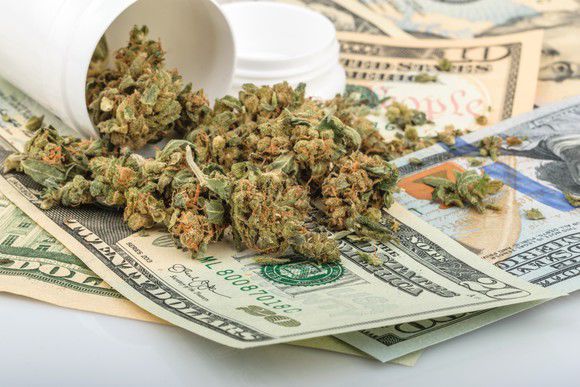When it comes to the market’s fastest-growing industries, you’d have a hard time topping legal marijuana. According to the latest report from Marijuana Business Dailyentitled “Marijuana Business Factbook 2017,” U.S. legal weed sales are expected to grow by approximately 30% in 2017, 45% the following year, and explode higher by roughly 300% between 2016 and 2021. This would push the U.S. legal cannabis market to around $17 billion by 2021.
Though that may sound like rapid growth, a lot hinges on what the U.S. federal government will do with regard to states’ rights. Now-former White House press secretary Sean Spicer intimated in February that a federal crackdown on pot could be coming, and Attorney General Jeff Sessions has, on more than one occasion, offered very negative views of cannabis’ expansion. The future of pot in the U.S. remains very much uncertain.
This Canadian pot stock could deliver 232% sales growth annually through 2019
What hasn’t been uncertain of late has been the growth rates from marijuana stocks in Canada. Unlike the U.S., which has restrictive federal marijuana laws, medical cannabis is legal in Canada. Additionally, its parliament is currently discussing legislation introduced by Prime Minister Justin Trudeau in April that would legalize recreational pot by July 1, 2018. Canada is aiming to become the first developed country to take the shackles off the weed industry, and Canadian-based marijuana stocks are benefiting big-time from it.
But one Canadian marijuana stock stands out above the rest for its rapid growth rate. In fact, between 2015 and 2019, taking into account its already reported fiscal 2015, 2016, and 2017 results, as well as financial institutions’ consensus estimates for fiscal 2018 and 2019, one company is offering up a jaw-dropping compound annual growth rate (CAGR). Say hello to Canopy Growth Corp. (NASDAQOTH:TWMJF).
Canopy Growth Corp. reports its results in Canadian dollars (CAD), so utilizing the translation of CAD to U.S. dollars as of Sept. 23, 2017, here’s a snapshot of the company’s reported and expected sales for each fiscal year between 2015 and 2019:
- 2015: $1.92 million (actual)
- 2016: $10.29 million (actual)
- 2017: $32.33 million (actual)
- 2018: $76.47 million (estimate)
- 2019: $232.46 million (estimate)
Run the math using a CAGR calculator, and it works out to an average growth rate of 232%.
Three reasons Canopy Growth is budding like a bean stalk
Perhaps the most exciting aspect of the company’s growth from the perspective of shareholders is that there isn’t a standout catalyst. Instead, three factors have converged to rapidly increase sales.
To begin with, Canopy Growth has been active on the acquisition front. Earlier this year, it completed the acquisition of Mettrum Health, which gave it access to about half of Canada’s medical cannabis patients. Around the same time, it also acquired land surrounding its headquarters for the purposes of expanding its production capacity. Whereas a number of its peers have chosen to expand organically, Canopy Growth has primarily been an aggressive acquirer of new capacity. The reason? Without having to take the time to develop new operations, it has a chance to get its foot in the door quicker than its competitors. And there very well could be a first-in-class growing capacity advantage if recreational weed is legalized next year.
Second, we’re seeing strong organic growth from the medical side of the business in Canada, even if it’s the recreational side of the business that’s expected to generate far more in annual sales. According to data from Health Canada in May, the number of eligible medical patients was growing by 10% per month. With exposure to about half of the country’s medical pot patients, it’s well positioned for strong sales growth.
And finally — and this is a little-known fact — Canopy Growth is one of just a handful of Canadian growers authorized to export their dried cannabis to foreign countries that have legalized medical cannabis. A good example is Germany, which recently legalized medical pot, but lacks the domestic production to accommodate patients. Canopy Growth and a small handful of other Canadian producers have been able to step in and fill that production void.
Two wildcards to watch out for
However, investors should also understand that it won’t necessarily be smooth sailing for Canopy Growth, even with its robust growth between 2015 and 2017, and estimates for that rapid sales growth to continue. There are two unanswered questions that could disrupt the company’s practically perfect sales trajectory.
First, the expectation has been built into the company’s future growth estimates that Canada will become the second country in the world, joining Uruguay, and the first developed one, to legalize recreational pot. But what if this doesn’t go as planned? Conservative members of Canada’s parliament have offered their concerns about legalizing adult-use weed. These include the potential for adolescents to get their hands on weed easier than ever with a home-grow option built into the law and penalties for driving under the influence of marijuana that aren’t believed to be strict enough.
Mayors from around the country have also complained that there isn’t enough time to get the proper regulatory bodies in place prior to a July 2018 legalization. In other words, don’t count your chickens before they’re hatched with regard to Canada legalizing recreational pot.
The other wildcard here is Health Canada, the regulatory body that oversees the health of the country’s citizens. In May, it announced plans to ease restrictions and improve approval times for growing licenses. In short, Health Canada just opened the door for a ton of new competition for Canopy Growth, which could adversely impact dried cannabis pricing and therefore margins. Depending on how quickly this competition ramps up, Canopy Growth could lose its first-in-class capacity advantage.
Because of the company’s dominant market share, it remains a marijuana stock to monitor very closely and possibly consider buying if Canada does indeed move forward with recreational legalization. Nevertheless, expect it to remain volatile and exceptionally pricey considering that full-year profits aren’t expected until 2019 at the earliest, according to Wall Street’s consensus estimates.
credit:fool.com













